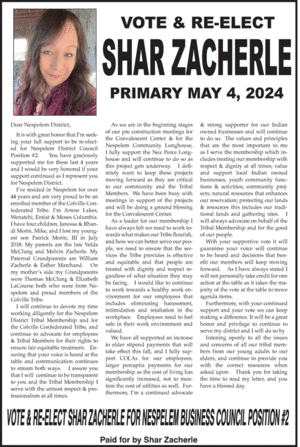Pathway discussion lists fears and research
Last updated 9/21/2016 at 9:48am
A large number of “not in my neighborhood” trail opponents turned out last Tuesday night to express their fears about Electric City’s Pathway and Trails plan.
Their appearance and comments dominated the first half of the city council meeting, and Mayor John Nordine’s explanation that no decision has been made about the trail was less than convincing to the crowd.
Several had signed up to address the council, but it was largely left to Cheryl Edick, who lives on Lakeview Avenue, to provide the reasons why they were opposed to the “waterfront path.”
In an open letter to the mayor and council, Edick stated several concerns:
• The current proposed route runs across her surveyed property.
• The front and back of her and others’ homes will be exposed to anyone using the trail and they will be losing their privacy.
• We don’t believe that people will essentially stay on the trail, and it will open up the possibility for criminal activity.
• Litter will become an issue. The city will have increased maintenance costs.
• People will toss cigarette butts around and it will increase fire danger.
• The flow of people will be a problem, and it will increase the possibility of accidents and bodily injury.
• Wildlife will be disturbed along the lake.
• Will 4-wheelers, golf carts be allowed? Will the path be plowed in the winter?
• Will it be open at night, and who will enforce park rules?
• We are all outraged at the exorbitant cost of the proposed trail.
“As residents of Electric City we are not opposed to improvements of our public areas or a walkway between Coulee Playland and North Dam Park,” Edick stated through her letter. “Those improvements would be highly visible, increase community pride and encourage tourists to stop and spend money.”
Mayor Nordine and several councilmembers responded that no decisions have been made on the trail or any other part of the proposed plan.
Councilmember Lonna Bussert said research on trails suggested that many of the fears of local residents were unfounded.
A research project by Headwaters Economics showed the following:
• Those who opposed a trail prior to construction generally find a trail to be a much better neighbor than they anticipated.
• In rural Methow, Washington, homes within one-quarter mile of trails showed a 10-percent increase in the value of their homes. One third of residents ranked recreational opportunity as the top reason they moved to the area. Ninety-three percent of residents reported that the trail network was either the most important factor or an important factor in their decision to buy property in the Methow Valley.
• In Seattle and upstate New York, adjacent property owners were concerned about trail-related crime before the trail was built. Researchers found no change in crime rate after the trail was built.
• Trails can generate business impacts and create new jobs by attracting visitors, especially overnight visitors. As more communities create distinct destinations that are also attractive places to live and work, a growing body of research shows how trails can contribute to their success.
• Destination trails attract visitors from outside.
• Trails can improve public health by increasing physical activity.
• Landowners can make it clear that trail users are not invited onto adjoining properties with no-trespassing signs.



Reader Comments(0)